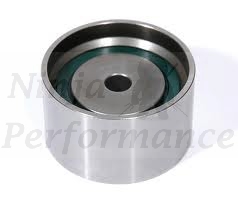BEG
Adventurer
My hydraulic timing belt tensioner failed on me the other day. After doing about an hour of highway driving at around 75mph, I slowed down to a stop light and heard what sounded like lifter tick but louder. That progressed to all out metal-to-metal clanging at which point I just about crapped my pants thinking I had skipped timing and bent valves. I had the Monty towed home and tore into it to see the damage. To my surprise, the engine was still in time and the belt had not skipped, but the tensioner was limp and the awful clanging was the sound of the tensioner pulley bracket banging against the tensioner body. I ordered a new tensioner and once it comes in I'll button it back up, but it made me think of how awful the Mitsu design is for such a critical component.
I've done plenty of timing belts and most have either a hydraulic or spring-adjusted solid tensioner where the tensioner itself sets the initial belt tension. The 6g74 requires you to set the initial tension and there's all kinds of opportunities for error: Does the eccentric pulley get torqued clockwise or counter clockwise? How do you maintain consistent torque on the eccentric pulley while simultaneously tightening the pulley bolt? How accurate is your measurement of the gap? When it comes to putting the pin back in the tensioner, how easy is "easy?" Aside from human error, there's also the chance of the tensioner leaking and failing without warning.
In my searches for a solution, I happened upon these tensioners for the DOHC 3.5:


They work in conjunction with a replacement non-eccentric pulley:

I understand the benefits of a hydraulic tensioner, but plenty of vehicles use solid tensioners. Even the Mitsu 3.0 V6 has a solid tensioner. A setup like this takes away a lot of the opportunity for error and mechanical failure. I'm planning on using a replacement hydraulic tensioner with an added safety hack from a Volvo, but I'm curious what everyone's thoughts are on using a solid tensioner for an expo vehicle. I'm thinking I might gut my old tensioner for the SOHC and adding a bolt and locknut as a replacement in case this new one fails.
TL;DR: Aftermarket solid tensioner with manual adjustment vs. complicated OEM hydraulic auto-tensioner?
I've done plenty of timing belts and most have either a hydraulic or spring-adjusted solid tensioner where the tensioner itself sets the initial belt tension. The 6g74 requires you to set the initial tension and there's all kinds of opportunities for error: Does the eccentric pulley get torqued clockwise or counter clockwise? How do you maintain consistent torque on the eccentric pulley while simultaneously tightening the pulley bolt? How accurate is your measurement of the gap? When it comes to putting the pin back in the tensioner, how easy is "easy?" Aside from human error, there's also the chance of the tensioner leaking and failing without warning.
In my searches for a solution, I happened upon these tensioners for the DOHC 3.5:


They work in conjunction with a replacement non-eccentric pulley:

I understand the benefits of a hydraulic tensioner, but plenty of vehicles use solid tensioners. Even the Mitsu 3.0 V6 has a solid tensioner. A setup like this takes away a lot of the opportunity for error and mechanical failure. I'm planning on using a replacement hydraulic tensioner with an added safety hack from a Volvo, but I'm curious what everyone's thoughts are on using a solid tensioner for an expo vehicle. I'm thinking I might gut my old tensioner for the SOHC and adding a bolt and locknut as a replacement in case this new one fails.
TL;DR: Aftermarket solid tensioner with manual adjustment vs. complicated OEM hydraulic auto-tensioner?


